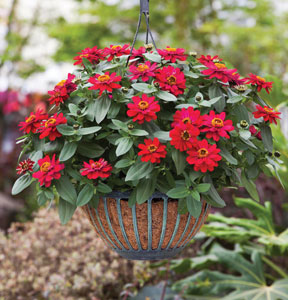11/26/2013
Double Profusion Zinnias Are Twice as Nice
Ken Harr

Sakata’s latest additions to the Profusion Double Zinnia series are Double Yellow, Double Hot Cherry and Double Deep Salmon. They all sport a grand show of long-lasting flowers, making them a natural choice for garden decorators and landscapers alike. Because of their extra petals and larger blooms, as well as Profusion’s ability to cover aging flowers, mass plantings are dynamite when viewed from a distance or up close. For retailers and landscapers looking for an exciting new offering, Double Profusions in these hot new colors offer exceptional performance and durability.
For growers, Profusion Double Zinnias offer great germination percentages at 90%+, and with Profusion’s high seed quality, you can translate this into more useable and transplantable seedlings. Strong and early vigor allows these zinnias to be transplanted easily with automatic transplanters with minimal mechanical damage. Generally a fast-turn crop, Profusions can be sown, transplanted and finished in as little as 7 to 8 weeks in large packs, and 8 to 10 weeks in larger size containers and hanging baskets.
Normally, zinnias are seen at retail once warm weather has arrived for the season; but don’t underestimate Profusion’s durability in the retail market. Profusions can be shipped with begonias, salvias and impatiens, and with the great new colors of the Double Profusions, extra sales can be achieved, with replenishment orders all but assured.
Growing tips
To ensure a successful crop, media pH during plug growth should be at 5.8 to 6.0. Radicle emergence will occur in as little as 3 to 4 days by keeping the media at moisture level 4 (wet but not saturated) with 100% humidity. Once the radicle emerges and cotyledons open, moisture levels can be reduced to a medium level (soil color changes from dark black to medium brown).
Lower humidity levels over the plug trays to 40% and begin feeding with 40 to 50 ppm nitrogen with calcium and potassium nitrates (14-2-14 or 13-2-13-6 Ca-3Mg). Profusion Zinnias are Facultative Short Day Plants (FSDP), which means growers should expose the crop to 4 hours of night interruption (10:00 p.m. to 2:00 a.m.) if day lengths are less than 11 hours to ensure vegetative growth. Bud initiation should take place 15 to 18 days after sow date; growers can bulk up seedlings and transplants with supplemental light achieving daily levels at 8 to 12 moles. At days 21 to 28, increasing the moles of light to 12 to 15 and adding supplemental HID light will result in increased basal branching.
Some key cultural points are:
- Feed transplants with a balanced calcium nitrate-based fertilizer at 100 to 150 ppm.
- Interveinal chlorosis on mature leaves indicates a lack of magnesium—supplement with magnesium sulfate (Epsom salts) at 16 oz./100 gal.
- Downward cupping of leaves can indicate too dry media or the E.C. is greater than 2.0.
- E.C. should be 1.25 to 1.5 range.
Growing Profusion Zinnias on the lean side, with less-than-adequate moisture levels can cause them to flower prematurely. However, pushing the crop with excessive ammonia and phosphorous can also result in lush, vegetative growth with delayed flowering. Growers can guard against excessive growth with applications of B-Nine, A-Rest, Bonzi or Sumagic. Profusion zinnias can also be controlled with a negative DIF at 5 to 15F (-15 to -9C).
Profusion’s radiant and unique colors, along with the new double-flowering varieties, will exhibit an extravagant show in the garden. Profusion Zinnias grows to 12- to 16-in. tall with excellent basal branching, allowing the plants to remain in color all summer. Plant Profusion zinnias in full sun to partial shade. Mulching display beds will allow the plants to retain moisture through the hot summer months and maintain their full appearance. The spectacular color show will draw consumers and gardeners back for more each season. And as an added bonus, growers and retailers can confidently state that rabbits and deer do not eat Profusion Zinnias in the landscape.
GT
Ken Harr is Product Technical Manager for Sakata Seed America. He can be reached at (408) 763-1319 or kharr@sakata.com.